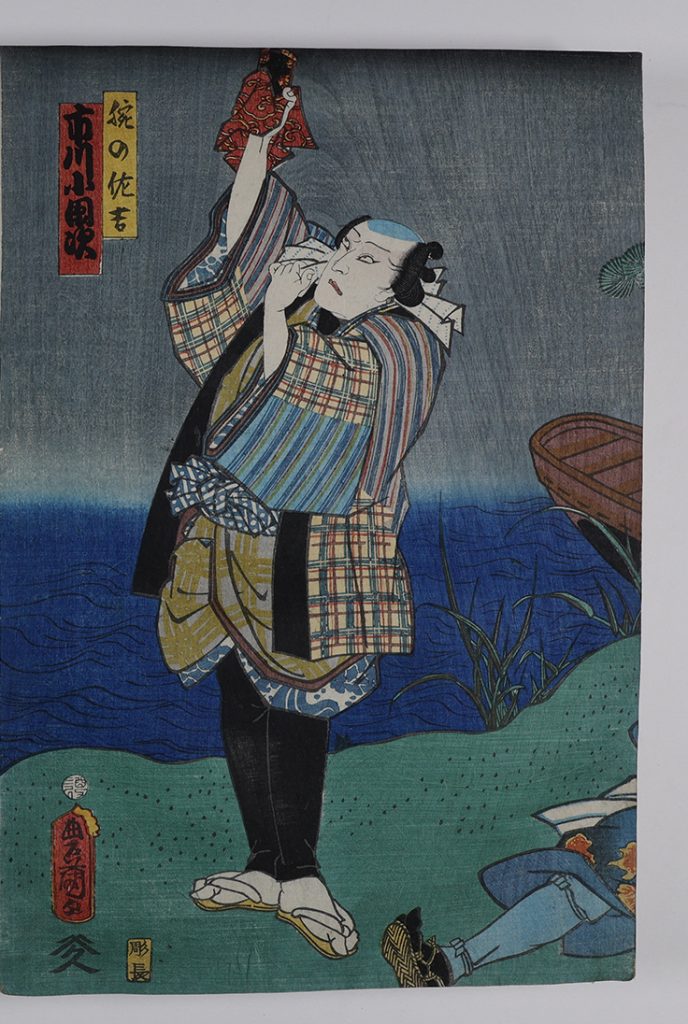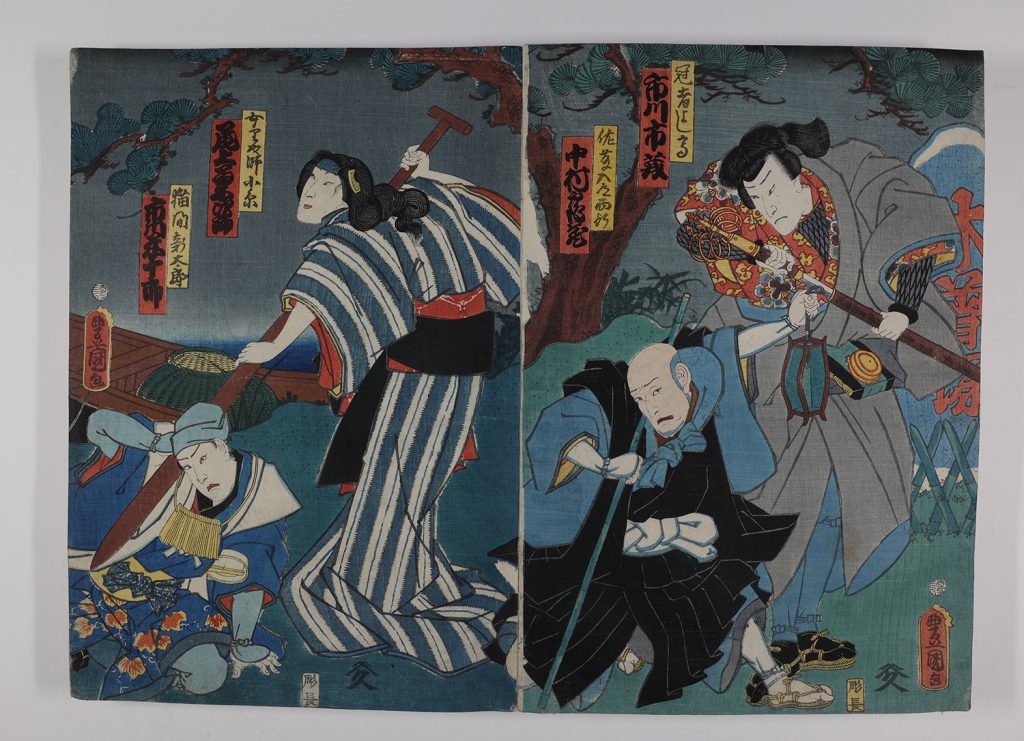Plates 54-56: Scene from the play Aioi Genji Takasago no Matsu
Plates 54-56: Scene from the play Aioi Genji Takasago no Matsu
Utagawa Kunisada 歌川 国貞 (1786 – 1865)
Scene from the play Aioi Genji Takasago no Matsu 相生源氏高砂松 (Twin Pines of Genji Takasago)1 (1861)
Ink and color on paper
Seals:
This triptych is an example of yakusha-e 役者絵, a genre of ukiyo-e which depicts kabuki actors. After the liberation of censorship regulations on ukiyo-e production in the late 1840s came a prolific period in Utagawa Kunisada’s career. Subsequently, he dominated the actor prints market in the 1850s and early 1860s.4 This triptych made by Kunisada depicts a scene of the kabuki play Aioi Genji Takasago no Matsu that was staged at the Morita Theater in Edo in 1861.5 The names of the cast are printed alongside their images, with bold scripts against the red background of the cartouches indicating the names of the actors and the thinner, slightly smaller scripts against the yellow background of the adjacent cartouches indicating the names of the characters being played. On plate 54, the far right print, Kaja Yoshitaka, played by actor Ichikawa Ichizō III 三代目市川市蔵 (1833 – 1865), is about to pull out his sword, intimidating the flustered Satō nyudo Saigyō, played by Nakamura Tsuruzō I 初代中村鶴蔵 (1809 – 1886). The center print, plate 55, has a similar composition with figures of mirrored gestures: Ichikawa Yonejūrō I 市川 米十郎 (1812 – 1866) plays the character Nekoma Shintaro, who is being pressed to the ground via a wooden stick by Onoe Kikujirō II 二代目尾上菊次郎 (1814 – 1875) as the character Onna Riyashi Koito. On plate 56 to the left, Ichikawa Kodanji IV 四代目市川小団次 (1812 – 1866) as Ude no Sakichi is holding up a red cloth with cloud patterns in yellow outlines, looking sternly to the left. Kunisada’s skillful representation of facial expressions and dynamic postures of the figures in action implies serious tensions between characters, luring viewers into the story of the play. Though the exact plot remains unclear, references to the early Noh 能 play Takasago 高砂 are present in the stage set depicted in the background of the print.
Noh theater, predating kabuki to fourteenth-century Japan, is the oldest form of Japanese theater and the direct progenitor of kabuki. Traditional Noh dramas tell stories with predominantly Buddhist themes, and their presentation emphasized dance and song with highly poetic renderings.6 Kabuki owes direct debts to Noh, borrowing much of the material including the subject matter and the stage set.7 The Noh play Takasago tells the legend of the paired pine trees of Sumiyoshi and Takasago. In the legend, a traveling Shinto priest and his attendants pay a visit to the bay at Takasago in Harima Province, where they encounter an old couple sweeping needles under a pine tree. The priest asks the couple to tell him the tale behind the pine tree and why they are taking care of it. The couple explains to him that the pine is the Takasago Pine, which shares roots with the distant Sumiyoshi Pine. The pines together are called aioi-no-matsu 相生松 (often translated as Twin Pines). The couple then revealed that they are the spirits of the pine trees, reunited after the spirit of Sumiyoshi Pine traveled an arduous journey to visit his wife, the Takasago Pine. The paired pine trees thus symbolize marriage and longevity. As seen in this triptych, the play Aioi Genji Takasago no Matsu has a stage set like that of the Noh drama Takasago. The Takasago Pine is characterized by the bifurcation in the trunk as it grows at the bay with a resting boat nearby. The scene also portrays a male and female character and three priest-related figures. The distinct difference is that, while the Noh play is light-hearted, the scene portrayed in the triptych implies conflict and tension. Even so, both the similarities and differences present in this set of prints by Kunisada illustrate the lineage of Noh plays in later Kabuki plays.
Lanzehang (Lillian) Ying
History of Art & Psychology
Class of 2022
Annotated Bibliography
“The database of ukiyo-e.” Waseda University Cultural Resource Database. The Tsubouchi Memorial Theatre Museum, Waseda University, 2017. https://archive.waseda.jp/archive.
Waseda University’s database of ukiyo-e has the record of many ukiyo-e prints, including this set. Many aspects of the prints (for example, the date of the performance and the cast names) are identified.
Japanese Noh Drama; Ten Plays Selected and Translated from the Japanese. Tokyo: Nippon Gakujutsu Shinkōkai, 1955.
This source includes ten selected Noh dramas translated from Japanese into English, including Takasago. The play of this triptych, Aioi Genji Takasago no Matsu, is an adaptation of the tale Aioi no matsu (paired pines) told in the Noh drama Takasago. Takasago‘s entire story and the script are interpreted and translated into English, which allows comparison to the scene depicted in the triptych with more details given the contextual information.
Marks, Andreas. Japanese Woodblock Prints: Artists, Publishers, and Masterworks: 1680 – 1900. Tokyo: Tuttle Publishing, 2010.
This book provides a detailed survey of all the major artists and publishers from the 1680s to the year 1900, incuding the artist and the publisher of this triptych, respectively Utagawa Kunisada and Yamamotoya Heikichi. The section on Kunisada in this book is particularly relevant because it mentions a period during which Kunisada returned to kabuki themes by depicting legends in kabuki. This thematic preference may indicate a connection with the choice of subject for this triptych, which is a kabuki adaptation of the legend of paired pines.
Britannica, T. Editors of Encyclopaedia. “Kabuki.” Encyclopedia Britannica, 2019. https://www.britannica.com/art/Kabuki.
This encyclopedic web source provides a comprehensive account on the development of kabuki, which encompasses the history of the form, the audience, and subject, purpose, and conventions. The source elucidates the connection between kabuki and the Noh theater and explains the historical context during which Noh and kabuki each developed.


